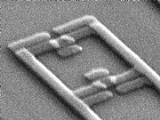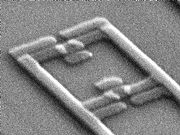
Flux qubit
Encyclopedia
In quantum computing, flux qubits (also known as persistent current qubits) are micrometer sized loops of superconducting metal interrupted by a number of Josephson junctions. The junction parameters are engineered during fabrication so that a persistent current will flow continuously when an external flux is applied. The computational basis states of the qubit are defined by the circulating currents which can flow either clockwise or counter-clockwise. These currents screen the applied flux limiting it to multiples of the flux quantum and give the qubit its name. When the applied flux through the loop area is close to a half integer number of flux quanta the two energy levels corresponding to the two directions of circulating current are brought close together and the loop may be operated as a qubit
.
 Computational operations are performed by pulsing the qubit with microwave
Computational operations are performed by pulsing the qubit with microwave
frequency radiation which has an energy comparable to that of the gap between the energy of the two basis states. Properly selected frequencies can put the qubit into a quantum superposition
of the two basis states while subsequent pulses can manipulate the probability weighting that the qubit will be measured in either of the two basis states, thus performing a computational operation.
s, etc., flux qubits are fabricated using techniques similar to those used in the micro-electronics industry. The devices are made on silicon wafers using electron beam lithography
and metallic thin film evaporation processes. To create the Josephson junction a technique known as shadow evaporation is normally used; this involves evaporating the source metal alternately at two angles through the lithography defined mask in the electron beam resist. This results in two overlapping layers of the superconducting metal, in between which a thin layer of insulator (normally aluminum oxide) is deposited.
or phase qubit
by the coupling energy and charging energy of its junctions. In the charge qubit regime the charging energy of the junctions dominates the coupling energy, while in a flux qubit the situation is reversed and the coupling energy dominates. Typically in a flux qubit the coupling energy is 10-100 times greater than the charging energy. It is this ratio that allows the cooper pairs to flow continuously around the loop, rather than tunnel discretely across the junctions as in a charge qubit.
Prof. Mooij's group at Delft in the Netherlands, along with collaborators, has pioneered flux qubit technology, and were the first to conceive, propose and implement flux qubits as they are known today. The Delft read-out scheme is based on a SQUID
loop that is inductively coupled to the qubit, the qubit's state influences the critical current of the SQUID. The critical current can then be read-out using ramped measurement currents through the SQUID. Recently the group has used the plasma frequency of the SQUID as the read-out variable.
Dr. Il'ichev's group at IPHT Jena
in Germany are using impedance measurement techniques based on the flux qubit influencing the resonant properties of a high quality tank circuit, which, like the Delft group is also inductively coupled to the qubit. In this scheme the qubit's magnetic susceptibility, which is defined by its state, changes the phase angle between the current and voltage when a small A.C. signal is passed into the tank circuit.
Recently Prof. Petrashov's group at Royal Holloway are using an Andreev interferometer probe to read out flux qubits. This read-out uses the phase influence of a superconductor on the conductance properties of a normal metal. A length of normal metal is connected at either end to either side of the qubit using superconducting leads, the phase across the qubit, which is defined by its state, is translated into the normal metal, the resistance of which is then read-out using low noise resistance measurements.
Qubit
In quantum computing, a qubit or quantum bit is a unit of quantum information—the quantum analogue of the classical bit—with additional dimensions associated to the quantum properties of a physical atom....
.

Microwave
Microwaves, a subset of radio waves, have wavelengths ranging from as long as one meter to as short as one millimeter, or equivalently, with frequencies between 300 MHz and 300 GHz. This broad definition includes both UHF and EHF , and various sources use different boundaries...
frequency radiation which has an energy comparable to that of the gap between the energy of the two basis states. Properly selected frequencies can put the qubit into a quantum superposition
Quantum superposition
Quantum superposition is a fundamental principle of quantum mechanics. It holds that a physical system exists in all its particular, theoretically possible states simultaneously; but, when measured, it gives a result corresponding to only one of the possible configurations.Mathematically, it...
of the two basis states while subsequent pulses can manipulate the probability weighting that the qubit will be measured in either of the two basis states, thus performing a computational operation.
Fabrication
Like most mesoscopic devices such as solid state qubits, single-electron transistors, quantum dotQuantum dot
A quantum dot is a portion of matter whose excitons are confined in all three spatial dimensions. Consequently, such materials have electronic properties intermediate between those of bulk semiconductors and those of discrete molecules. They were discovered at the beginning of the 1980s by Alexei...
s, etc., flux qubits are fabricated using techniques similar to those used in the micro-electronics industry. The devices are made on silicon wafers using electron beam lithography
Electron beam lithography
Electron beam lithography is the practice of emitting a beam of electrons in a patterned fashion across a surface covered with a film , and of selectively removing either exposed or non-exposed regions of the resist...
and metallic thin film evaporation processes. To create the Josephson junction a technique known as shadow evaporation is normally used; this involves evaporating the source metal alternately at two angles through the lithography defined mask in the electron beam resist. This results in two overlapping layers of the superconducting metal, in between which a thin layer of insulator (normally aluminum oxide) is deposited.
Flux qubit parameters
The flux qubit is distinguished from other types of superconducting qubit such as the charge qubitCharge qubit
In quantum computing, a charge qubit is a superconducting qubit whose basis states are charge states . A charge qubit is formed by a tiny superconducting island coupled by a Josephson junction to a superconducting reservoir...
or phase qubit
Phase qubit
The phase qubit is a superconducting device based on the superconductor-insulator-superconductor Josephson junction, designed to operate as a quantum bit, or qubit. The phase qubit is closely related, yet distinct from, the flux qubit and the charge qubit, which are also quantum bits implemented...
by the coupling energy and charging energy of its junctions. In the charge qubit regime the charging energy of the junctions dominates the coupling energy, while in a flux qubit the situation is reversed and the coupling energy dominates. Typically in a flux qubit the coupling energy is 10-100 times greater than the charging energy. It is this ratio that allows the cooper pairs to flow continuously around the loop, rather than tunnel discretely across the junctions as in a charge qubit.
Readout
Like all quantum bits, Flux qubits require a suitably sensitive probe coupled to it in order to measure its state after a computation has been carried out. Such quantum probes should introduce as little back-action as possible onto the qubit during measurement. Ideally they should be decoupled during computation and then turned "on" for a short time during read-out. Read-out probes for flux qubits work by interacting with one of the qubit's macroscopic variables, such as the circulating current, the flux within the loop or the macroscopic phase of the superconductor. This interaction then changes some variable of the read-out probe which can be measured using conventional low-noise electronics. The read-out probe is typically the technology aspect that separates the research of different University groups working on flux qubits.Prof. Mooij's group at Delft in the Netherlands, along with collaborators, has pioneered flux qubit technology, and were the first to conceive, propose and implement flux qubits as they are known today. The Delft read-out scheme is based on a SQUID
SQUID
A SQUID is a very sensitive magnetometer used to measure extremely weak magnetic fields, based on superconducting loops containing Josephson junctions....
loop that is inductively coupled to the qubit, the qubit's state influences the critical current of the SQUID. The critical current can then be read-out using ramped measurement currents through the SQUID. Recently the group has used the plasma frequency of the SQUID as the read-out variable.
Dr. Il'ichev's group at IPHT Jena
IPHT Jena
The Institute of Photonic Technology is a non-university research facility in Jena, Thuringia, Germany. Focused on applications for various physical systems, the Institute's mandate is to find solutions to challenges in high technology systems...
in Germany are using impedance measurement techniques based on the flux qubit influencing the resonant properties of a high quality tank circuit, which, like the Delft group is also inductively coupled to the qubit. In this scheme the qubit's magnetic susceptibility, which is defined by its state, changes the phase angle between the current and voltage when a small A.C. signal is passed into the tank circuit.
Recently Prof. Petrashov's group at Royal Holloway are using an Andreev interferometer probe to read out flux qubits. This read-out uses the phase influence of a superconductor on the conductance properties of a normal metal. A length of normal metal is connected at either end to either side of the qubit using superconducting leads, the phase across the qubit, which is defined by its state, is translated into the normal metal, the resistance of which is then read-out using low noise resistance measurements.

